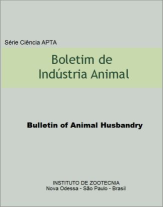Lactation curves of crossbred taurine x zebu cows
DOI:
https://doi.org/10.17523/bia.v73n2p118Keywords:
crossings, mathematical models, milk yield, modelingAbstract
The objective of this study was to compare mathematical equations described in the literature, to identify the equation that best describes milk yield, and to estimate some components of the lactation curve of cows of high genetic variability resulting from the crossing of taurine (Bos taurus) and Zebu animals (Bos indicus), raised in a semi-intensive production system in Sergipe. A total of 1,496 milk yield records were used. Test-day milk yields were obtained at intervals of 30 days from 2011 to 2012. The following four mathematical models were applied to fit the average curve: model of Nelder, 1966 (ND), Wood, 1967 (WD), Bianchini Sobrinho, 1984 (BS) and Wilmink, 1987 (WK). The criteria used to verify the goodness-of-fit of each function were the adjusted coefficient of determination (Ra2), residual plot, and percentage of deviation between observed and expected production. The mean Ra2 values were higher than 0.80 for the models used, except for the WK model. All curves exhibited typical patterns. The WD and WK functions underestimated 305-day cumulative milk yield and presented greater deviations from the observed production. The remaining functions exhibited a similar trend in the residual plot. However, the inverse polynomial function (ND) provided better estimates of the variables that comprise the lactation curve of cows resulting from crossings of Bos taurus x Bos indicus animals.
Keywords:
Downloads
Downloads
Published
Issue
Section
License
Os autores não serão remunerados pela publicação de trabalhos, pois devem abrir mão de seus direitos autorais em favor deste periódico. Por outro lado, os autores ficam autorizados a publicar seus artigos, simultaneamente, em repositórios da instituição de sua origem, desde que citada a fonte da publicação original seja Boletim de Indústria Animal. A revista se reserva o direito de efetuar, nos originais, alterações de ordem normativa, ortográfica e gramatical, com vistas a manter o padrão culto da língua e a credibilidade do veículo. Respeitará, no entanto, o estilo de escrever dos autores. Alterações, correções ou sugestões de ordem conceitual serão encaminhadas aos autores, quando necessário. Nesses casos, os artigos, depois de adequados, deverão ser submetidos a nova apreciação. As opiniões emitidas pelos autores dos artigos são de sua exclusiva responsabilidade. Todo o conteúdo deste periódico, exceto onde está identificado, está licenciado sob a Licença Creative Commons Attribution (CC-BY-NC). A condição BY implica que os licenciados podem copiar, distribuir, exibir e executar a obra e fazer trabalhos derivados com base em que só se dão o autor ou licenciante os créditos na forma especificada por estes. A cláusula NC significa que os licenciados podem copiar, distribuir, exibir e executar a obra e fazer trabalhos derivados com base apenas para fins não comerciais.













